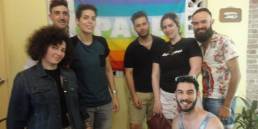As a Miami born-and-raised Cuban American, I grew up with many misconceptions about Cuba, its government, and its people. Time and time again, I would search for articles or videos on LGBTQ life in Cuba, but what I found was very limiting and unsatisfying. With the exception of a few films, I found that the drag community was not well documented and therefore I wanted to build my own opinions on what it is like to be a drag queen in current day Cuba. I ventured to Cuba with the CubaOne organization on their first LGBTQ focused trip. The purpose of this trip was for six fellows Cuban Americans and me to connect to our Cuban roots, as well as attend Cuba’s ‘Dia contra la homofobia’. Not only did we learn about the country’s rich history, but we came out of it with a completely transformed perception of Cuba, its politics, and the local people – as well as with friendships that will last a lifetime.
My expectations on this trip were to meet the queer Cuban people, more specifically the LGBTQ activists, artists, and performers who are making a difference in their communities. Those expectations were certainly met and surpassed, as I met many passionate and educated locals who were genuinely interested in sharing their stories and struggles on the island. Out of the many people I met, there are a few that really impacted my experience. I visited the studio of a local artist R10, whose current body of work is a cheeky statement on US and Cuban relations (and tensions). I went behind the scenes at Clandestina, an LGBTQ owned and operated store that sells prints, novelties, and manufactures clothing from recycled garments. And best of all, I got to see several drag shows, as well have an in-depth conversation with Chantal, one of Havana’s most popular drag performers about the challenges she and other queens face as performers in current day Cuba. Chantal has been in the business for over ten years and explains to me that it is incredibly difficult for her and other performers to get essential items such as fabric for costumes, pairs of eyelashes, and heels in the right size. They rely greatly on the kindness of tourists and friends outside of Cuba for these items, but sometimes have to go without and it affects their ability to work comfortably.
I experienced a strong sense of Cuban identity, togetherness, and communal support that is sometimes absent in other communities. Because of their history of political and civil strife, I believe the Cuban people have learned to rely on each other, build strong connections, and band together for the greater good. Regardless of the islands precarious past with the US, everyone I met welcomed us with open arms and open hearts and was genuinely interested in us as much as we were with them.
I plan on continuing the communication and outreach with everyone I met during my trip, and I am currently in the planning stages of setting up a charity that’ll benefit these LGBTQ artists and performers on the island. I welcome any donations, whether it is wigs, lashes, nails, accessories, fabrics, or cosmetics that could be of use to any of Cuba’s talented performers.

This article previously appeared in OnCuba Magazine.
antoniomendez
Miami based drag queen. Best of Miami 2017 & 2019. Antonio traveled to Cuba with CubaOne in May of 2017.

